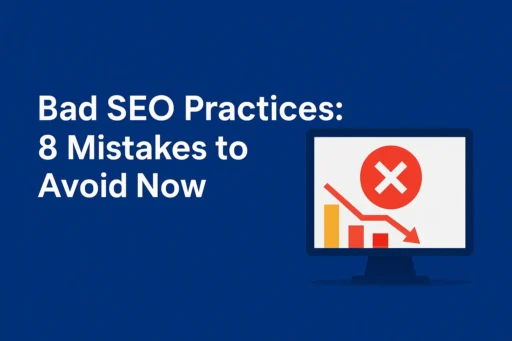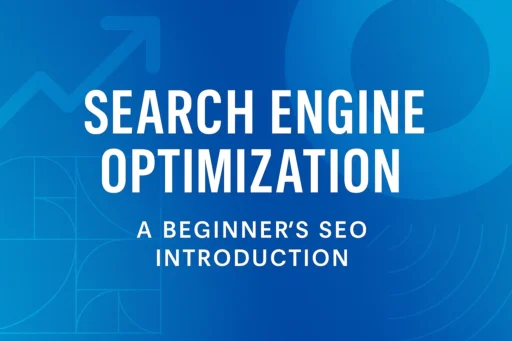Bad SEO practices can sabotage your website’s visibility faster than you might think. In 2025, search engines have become increasingly sophisticated at identifying and penalizing websites that use outdated or manipulative tactics. At Search Savvy, we’ve seen countless businesses unknowingly damage their rankings by implementing strategies that no longer work-or worse, strategies that actively harm their online presence.
SEO practices evolve constantly, and what worked five years ago might now be considered a penalty-worthy offense. With search engines prioritizing content that’s helpful, trustworthy, and authored by experts, understanding which bad SEO practices to avoid has never been more critical. According to Search Savvy’s insights, the key to sustainable growth lies in recognizing these pitfalls early and implementing white hat alternatives instead.
This comprehensive guide explores eight of the most damaging bad SEO practices still plaguing websites today, along with actionable solutions to correct course and optimize effectively.
Why Are Bad SEO Practices So Harmful in 2025?
Bad SEO practices refer to outdated, unethical, or poorly executed strategies that hinder rather than help your website’s performance. These tactics fail to boost visibility and can lead to severe consequences, including algorithmic penalties, manual actions from Google’s webspam team, and permanent damage to your site’s reputation.
The top three Google search results get 54.4% of all clicks, and leads from SEO have a 14.6% close rate. When bad SEO practices cause your rankings to plummet, you’re not just losing visibility-you’re losing qualified leads and revenue. At Search Savvy, we emphasize that ethical SEO techniques build domain authority and foster long-term trust with both search engines and your audience.
How Does Keyword Stuffing Damage Your Rankings?
Bad SEO practices start with one of the most notorious offenders: keyword stuffing. This involves excessively cramming keywords into your content in an unnatural way, hoping to manipulate search engine rankings.
Keyword stuffing makes content unreadable and harms user experience. Modern search engines have evolved far beyond simple keyword matching-they now analyze context, user intent, and content quality. An example of keyword stuffing might look like: “Our best CRM software is the best CRM software for small businesses because this best CRM software increases productivity.”
Google’s spam policies explicitly prohibit keyword manipulation, and violations can result in significant ranking penalties.
What to Do Instead:
Focus on strategic keyword placement that prioritizes readability. Use your target keywords naturally in:
- Title tags and meta descriptions
- H1 and H2 headings
- The first paragraph and conclusion
- Image alt text and URL structure
Write for humans first, search engines second. A good rule of thumb is to write for your audience first and optimize for search engines second.
What Is Search Intent Neglect and Why Does It Matter?
SEO practices that ignore search intent represent one of the most common mistakes businesses make in 2025. Search intent refers to the underlying reason behind a user’s query-whether they’re looking to learn, buy, compare, or navigate.
If someone searches “pest control tips,” they probably want to find a list of steps they can take to prevent or remove pests in their home. When businesses target keywords without addressing the actual search intent, they create content that fails to satisfy users, resulting in high bounce rates and poor rankings.
Understanding search intent is fundamental to Google’s helpful content system, which evaluates whether content truly serves user needs.
What to Do Instead:
Before creating content, identify the search intent behind your target keywords:
- Informational intent: Provide comprehensive guides, how-tos, and educational content
- Navigational intent: Optimize brand and product pages
- Commercial intent: Create comparison articles and reviews
- Transactional intent: Focus on product pages with clear calls-to-action
Analyze the top-ranking pages for your target keywords to understand what content format and angle Google considers most relevant.
How Does Low-Quality Content Affect Your SEO?
Bad SEO practices often manifest through shallow, generic content that provides no real value or expertise. 29.3% of respondents identified content that doesn’t provide real value or expertise as the most problematic bad SEO practice in a recent survey of 58 SEO professionals and content marketers.
Search engines in 2025 prioritize content that demonstrates Experience, Expertise, Authoritativeness, and Trustworthiness (E-E-A-T). Generic content that simply rehashes existing information without offering unique insights struggles to rank.
What to Do Instead:
Create content that stands out by:
- Writing from experience: Share what you’ve personally tested or learned
- Including original data: Conduct surveys, case studies, or proprietary research
- Adding expert insights: Interview industry authorities and include their perspectives
- Providing actionable advice: Give readers specific steps they can implement immediately
At Search Savvy, we recommend investing in comprehensive content that thoroughly covers topics rather than publishing numerous shallow articles.
Why Is Relying on AI-Generated Content Without Editing a Bad SEO Practice?
SEO practices in 2025 must address the elephant in the room: AI-generated content. Close to 7% of survey participants say publishing generic, AI-generated content is the most problematic bad SEO practice.
While AI tools can support content creation, publishing unedited AI content creates generic, formulaic articles that lack the human expertise and unique perspective search engines now prioritize. Google’s position on AI-generated content is clear: quality matters more than production method.
What to Do Instead:
Use AI strategically as a starting point, not a replacement:
- Make meaningful edits: Go beyond surface tweaks. Add real examples, expert insights, and personal experience
- Restructure for clarity: Improve logical flow and fill gaps AI might miss
- Inject originality: Include unique data, case studies, and expert quotes
- Improve readability: Simplify language and make content accessible to your target audience
The goal is to create content that no other website could produce-content that reflects your unique expertise and perspective.
What Are Link Schemes and Why Should You Avoid Them?
Bad SEO practices involving manipulative link building remain a serious concern. Companies can purposefully or unknowingly fall prey to link schemes, the black hat SEO practice of buying or selling links to artificially inflate search rankings.
Common link schemes include:
- Private blog networks (PBNs)
- Buying backlinks from low-quality websites
- Excessive link exchanges
- Link farming networks
- Spammy blog comments with links
Google’s Googlebot web crawler detects about 99% of spam content or about 40 billion spam pages per day.
What to Do Instead:
Focus on earning high-quality backlinks naturally:
- Create linkable assets: Develop original research, comprehensive guides, infographics, and data visualizations
- Build genuine relationships: Connect with authoritative sources in your industry
- Pursue digital PR: Earn media mentions through newsworthy content and expert commentary
- Guest post strategically: Write valuable content for reputable publications (not for link manipulation)
A few strong, relevant backlinks can outweigh hundreds of weak ones. Quality always trumps quantity in modern link building. Learn more about link building best practices from industry experts.
How Do Mobile Optimization Issues Hurt Your SEO?
SEO practices that neglect mobile optimization represent a critical mistake in 2025. Because the bulk of searches is now conducted on mobile devices, Google crawls and indexes mobile-first by default.
Poor mobile experience includes slow loading times, unresponsive design, difficult navigation, and content that doesn’t adapt to smaller screens.
What to Do Instead:
Ensure your website is fully mobile-optimized:
- Implement responsive design: Your site should adapt seamlessly to all screen sizes
- Optimize page speed: The average voice search result page loads in 4.6 seconds, which is 52% faster than the average webpage
- Simplify navigation: Make buttons easy to tap and menus easy to browse on mobile
- Test regularly: Use Google Search Console’s mobile usability report to identify issues
- Improve Core Web Vitals: Focus on Largest Contentful Paint (LCP), First Input Delay (FID), and Cumulative Layout Shift (CLS)
Mobile optimization isn’t optional-it’s foundational to modern SEO success. Monitor your site’s performance with Google’s PageSpeed Insights tool.
What Is Cloaking and Why Is It Penalized?
Bad SEO practices don’t get much more deceptive than cloaking. Cloaking is the deceptive practice of showing one landing page to search engines and a significantly different one to users.
This black hat technique attempts to trick search engines by displaying optimized content to crawlers while showing users entirely different content. Similarly, sneaky redirects send users to unexpected pages.
What to Do Instead:
Always maintain transparency between what search engines and users see:
- Ensure your website content is consistent for all visitors
- Use proper 301 redirects for permanent changes and 302 redirects for temporary ones
- Implement canonical tags correctly to address duplicate content concerns
- Follow Google’s Search Essentials precisely
When detected, Google will likely demote or completely remove your pages from search results. The risk simply isn’t worth it.
Why Does Ignoring Voice Search Optimization Limit Your Reach?
SEO practices that fail to account for voice search represent a growing blind spot. 153.5 million U.S. users rely on voice assistants in 2025, up 2.5% from 2024, and voice searches now comprise over 50% of all online searches in 2025.
Voice queries differ significantly from typed searches-they’re longer, more conversational, and often question-based. Someone might type “best smartphones 2025” but say aloud, “What are the most affordable smartphones to buy in 2025 with top camera features?”
What to Do Instead:
Optimize your content for voice search and AI-powered assistants:
- Target conversational long-tail keywords: Focus on how people naturally speak
- Use question-based headings: Structure content around “how,” “what,” “why,” “when,” and “where” questions
- Create FAQ sections: Provide concise answers to common questions
- Implement structured data: Use FAQ schema and HowTo schema to increase the likelihood of your content being pulled into voice search results
- Optimize for local search: Over 55% of consumers use voice search to find local businesses
- Improve page speed: Voice assistants prioritize fast-loading pages
- Write conversationally: Use natural language that mirrors how people speak
Voice search optimization is no longer optional for businesses wanting to remain competitive in 2025. Learn more about voice search optimization strategies from leading SEO platforms.
Frequently Asked Questions
What are bad SEO practices?
Bad SEO practices are outdated, unethical, or poorly executed strategies that violate search engine guidelines or negatively affect user experience. They include tactics like keyword stuffing, link schemes, cloaking, duplicate content, and publishing low-quality content that fails to provide genuine value.
How long does it take to recover from SEO penalties?
Recovery time varies based on penalty severity. For algorithmic penalties, once you fix the issue, Google will remove the penalty the next time it revisits your page. Manual penalties require submitting a reconsideration request through Google Search Console and can take several months to a year to fully recover, especially if extensive cleanup is needed.
Can AI-generated content rank in search engines?
AI-generated content can rank if it’s substantially edited, includes unique insights, and provides genuine value. The key is making meaningful edits that add real examples, expert insights, and personal experience, while improving readability and filling in gaps AI might miss. Raw AI content without human expertise typically struggles to rank.
How many backlinks do I need for good SEO?
Quality matters far more than quantity. A few strong, relevant backlinks from authoritative sources can outweigh hundreds of weak ones. Focus on earning contextually relevant links from trusted publishers in your industry rather than pursuing raw link counts.
Why is mobile optimization important for SEO?
Google crawls and indexes mobile-first by default because the bulk of searches is now conducted on mobile devices. Poor mobile experience leads to higher bounce rates, lower rankings, and missed opportunities to connect with the majority of your potential audience.
What should I do if my website has been penalized?
First, identify the specific issue causing the penalty through Google Search Console. Remove or fix problematic content, disavow harmful backlinks, and ensure your site follows Google’s guidelines. For manual penalties, submit a reconsideration request explaining what you’ve fixed. Consider consulting with SEO professionals if you’re uncertain about the recovery process.
Conclusion
Bad SEO practices can devastate your online visibility, but understanding and avoiding them positions your website for sustainable, long-term success. The eight practices we’ve covered-keyword stuffing, search intent neglect, low-quality content, over-reliance on unedited AI content, link schemes, mobile optimization failures, cloaking, and ignoring voice search-represent the most common and damaging mistakes businesses make in 2025.
SEO practices that work today prioritize user experience, genuine expertise, and ethical tactics that align with search engine guidelines. By focusing on creating valuable content, earning quality backlinks naturally, optimizing for mobile and voice search, and maintaining transparency, you’ll build authority and trust that translates into consistent organic traffic.
At Search Savvy, we believe the future of SEO belongs to businesses that put users first and search engines second. Start implementing these corrective strategies today, and you’ll see not just better rankings, but more qualified traffic that converts into real business results.
Ready to transform your SEO strategy? The best time to start was yesterday-the second best time is now.
Further Reading:







